Top 10 AI-Powered Data Analytics Tools (2025)

The contemporary business environment requires the smart way of processing large quantities of data in an effective manner. The latest development of business intelligence is the use of AI-Powered Data Analytics Tools, which has revolutionized the way businesses interpret information contained within large datasets. These advanced systems utilize artificial intelligence to automate the process of data processing and identification of invisible patterns and provide predictive intelligence that can guide strategic decisions.
With 2025 around the corner, these game-changer tools are becoming more common in the various businesses in order to sustain competitive edges and streamline operational functions in a digital-age market that continuously changes.
What Are AI-Powered Data Analytics Tools?
AI-Powered Data Analytics Tools is the newest business intelligence technology, which incorporates the potential of artificial intelligence with the conventional data analysis techniques. The category of technology involved in the platforms entails the incorporation of machine learning algorithms, natural language processing, and automatic creation of insights, which converts raw information to actionable intelligence. These tools differ greatly with the traditional analytics tools where one would need to do manual activities to discover trends, make forecasts, and recommend actions.
The key functionalities are automated data cleansing, smart visualization, upcoming modeling, and continuous examination. An AI-Powered Data Analytics Tool is basically democratizing data science because it helps to simplify the complex data science process and thus enables the users to utilize them despite their level of technical knowledge.
Difference between AI and Traditional Data Analytics
- RealTime: AI analytics is also capable of processing high volumes of data at unimaginable speed such as the real time and the traditional method is time consuming and requires resources to massage that much data.
- Accuracy: The accuracy level of machine learning algorithms is more in pattern recognition than the traditional methods based on the traditional methodologies which have fixed analytic models.
- Scalability: AI-based systems will be able to handle more data and complexity levels easily when compared to more traditional systems which have problems processing large-scale data.
- Insights: AI transforms into reflective and prescriptive insights in autopilot that is far different than real-life analytics which focuses primarily on the descriptive outcome of the past data.
Benefits of Using AI in Data Analytics
Intelligent analytics platforms are transforming the conventional business intelligence strategy to provide modern businesses with new dimensions of benefits never before seen. These are next-level solutions that allow organizations to get more out of their data assets.
- Productivity: AI conversely saves plenty of time in making ready and scrutinizing the information and enables squads to get well in progression programs.
- Accuracy: Machine learning improves the rate of accuracy and reduces biasness among human errors and gives better analytic output as well as competitive business insights.
- Scalability: AI systems can handle more and more data and complexity automatically without increasing the number of manual resources and necessitating the change in an infrastructure.
- Cost-effectiveness: Automation cuts operational cost and increases the payoff by enhancing decision making and optimisation of resources.
- Innovation: With the help of AI, one can identify previously unidentified patterns and correlations that lead to disruptive breakthrough insights to power competitive advantages.
Key Features of AI-Driven Analytics Platforms
The advanced artificial intelligence features of current analytics applications are reshaping the mindset of companies based on decisions, driven by data. These are the most high-tech features of the development of business intelligence.
- Automation: Smart platforms perform auto ingestion, cleaning, transformation, and analysis of data without involving a lot of technical skills or any manual requirement.
- Visualization: AI can create dynamic, interactive dashboards and charts that will adjust to the preferences of the user and result in the most pertinent outcomes.
- Prediction: Machine learning algorithms are able to predict the future trend, customer behavior and market situations with accuracy and confidence ratings that are unheard of.
- Integration: Plug-and-play with the current business systems, databases, and third-party applications provide an entire data ecosystem, integration and access.
- Personalization: AI will customize the analytical experience to the roles of a user, user preferences, and your history of interaction and enable a high level of efficiency during the workflow.
Use Cases Across Industries
| Industry | Use Case |
| Healthcare | Patient diagnosis prediction |
| Retail | Customer behavior analysis |
| Finance | Fraud detection systems |
| Manufacturing | Predictive maintenance solutions |
| Transportation | Route optimization planning |
| Education | Student performance tracking |
| Energy | Smart grid management |
| Marketing | Campaign performance analysis |
Top 10 AI-Powered Data Analytics Tools (2025)
1. Tableau

Tableau is one of the market leaders in data visualization and analytics, standing out among AI-powered data analytics tools by providing a full capacity of AI-driven features that create value out of messy data, making it valuable. This highly robust tool achieves a fine balance between an understandable drag-and-drop interface and machine learning-based algorithms to offer unmatched analytical experiences. Users are capable of developing beautiful visualizations, completing sophisticated statistics, and even collaborating across the teams.
The ability of the platform to process natural language enables one to pose queries in simple English language and get clear visual images. Tableau has great compatibility with Salesforce data, and broad third-party connectivity which makes it a perfect tool to integrate a business that comes with a lot of business intelligence.
Key AI Features:
- An easy way to explore data using natural language query processing
- Automated discernment of patterns and understanding development
- The ability to forecast and predict
- Intelligent cleaning and preparing tools
- Artificial Intelligence-based dashboards and recommendations and optimization
Best Use Case: Large organizations that need to have powerful business intelligence and visualization capabilities across the entire enterprise.
Pricing: Custom pricing
Website: https://www.tableau.com/
2. Polymer
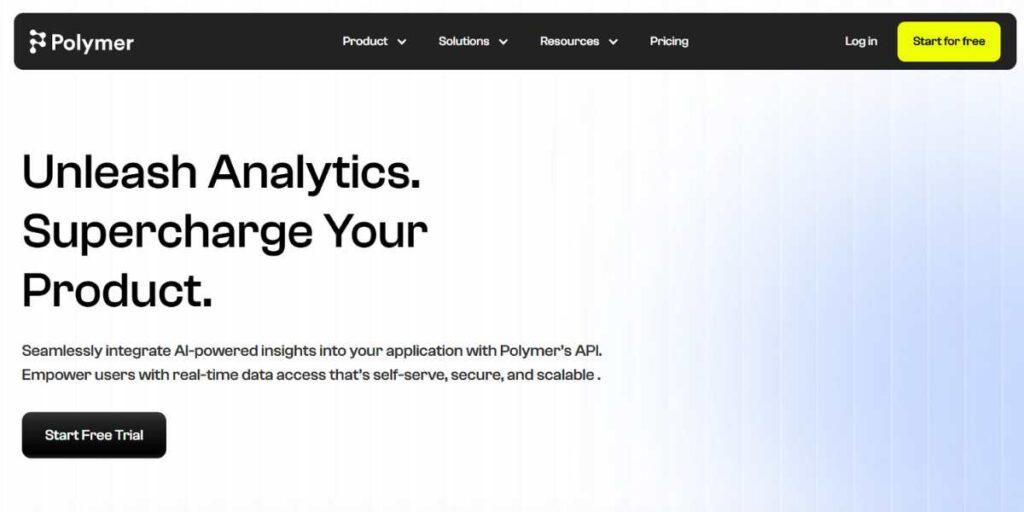
The concept of Polymer is a new way of understanding data analytics and aims at being simple and understandable by non-technical audiences. Among AI-powered data analytics tools, this is one that converts mere spreadsheets into smart databases that have dynamic filtering, sorting, and querying features. This platform focuses on data cleaning and the transformation that occurs automatically, and manual tasks related to data preparation are not necessary.
The online interface of Polymer is also in the form of interactive dashboards that refresh automatically, thus allowing users to assess business metrics and important performance indicators at a glance.
Key AI Features:
- Data cleaning and transformation carried out by machine
- Advanced interactive dashboards without needing to write any code
- Smart data types recognition and optimization
- Reporting and real time analytics
- Intelligent suggestions of data visualization
Best Use Case: Enterprises in small to medium business where inexpensive, easy to use analytics is needed without technical requirements.
Pricing: $25/mo
Website: https://www.polymersearch.com/
3. Domo
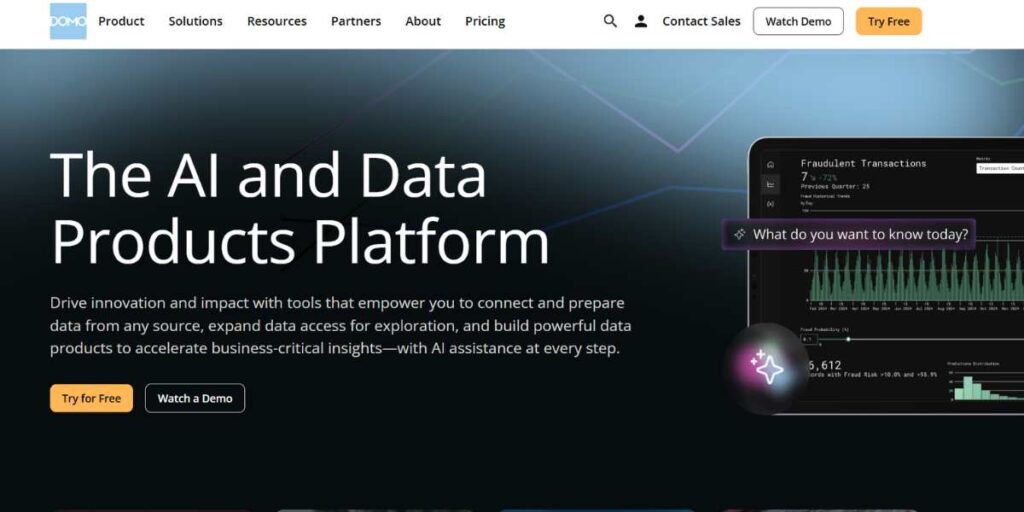
Domo is a feature-rich end-to-end data platform that seeks to make complex data management and analysis processes work easier. As one of the leading AI-powered data analytics tools, it integrates data, transforms, and visualizes data in a single environment. The AI service layer of the platform allows users to create, train, and deploy machine learning models without in-depth knowledge of data science. Using Domo, users can communicate with their data in natural language through a built-in conversational analytics feature.
It promises to be useful when it comes to business-related use cases because the platform comes with ready-made AI models for demand forecasting and sentiment analysis.
Key AI Features:
- Natural language processing conversational analytics
- Predictive and sentiment analysis AI models ready-made
- Data transformation and data preparation, automated.
- Planning and execution of machine learning systems
- Data exploration and finding of insight with support of AI
Best Use Case: Large companies that need to have strong data management and AI analytics services.
Pricing: Custom pricing
Website: https://www.domo.com/
4. Microsoft Power BI
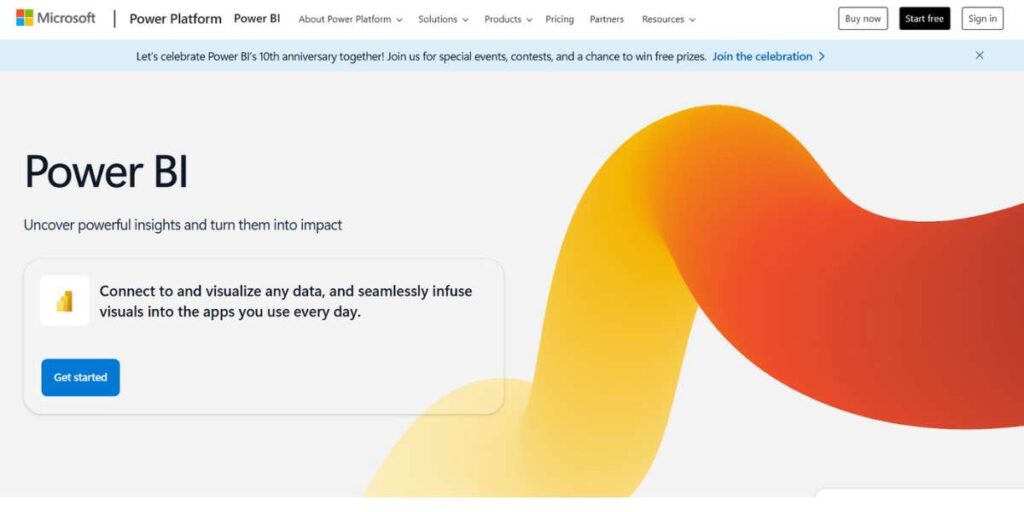
Microsoft Power BI is focused on integration with the overall Microsoft ecosystem, which makes it more readily usable, and more potentially powerful in analysis, to businesses already using Office products. As one of the most widely used AI-powered data analytics tools, it features natural language processing capabilities that allow users to make queries about their data and get a visual output. Everything about the platform is scalable, which makes it applicable even when processing large datasets with the expected high performance rate.
Power BI excels because of its wide range of data sources integration and easy interface, which needs minimal training for Microsoft users. The tool offers superior visual options and real-time collaborative features that make the team more productive.
Key AI Features:
- Natural language query processing and ideas
- Data modeling autonomy and relationship inferencing
- Anomaly Hunt and quick insights powered by Ai
- Predictive and forecasting analytics
- Intelligent authoring of reports
Best Use Case: Organizations with high investments in the Microsoft ecosystem with the intention of integrated business intelligence aspects.
Pricing: $14.00 user/month
Website: https://www.microsoft.com/en-us/power-platform/products/power-bi
5. Qlik
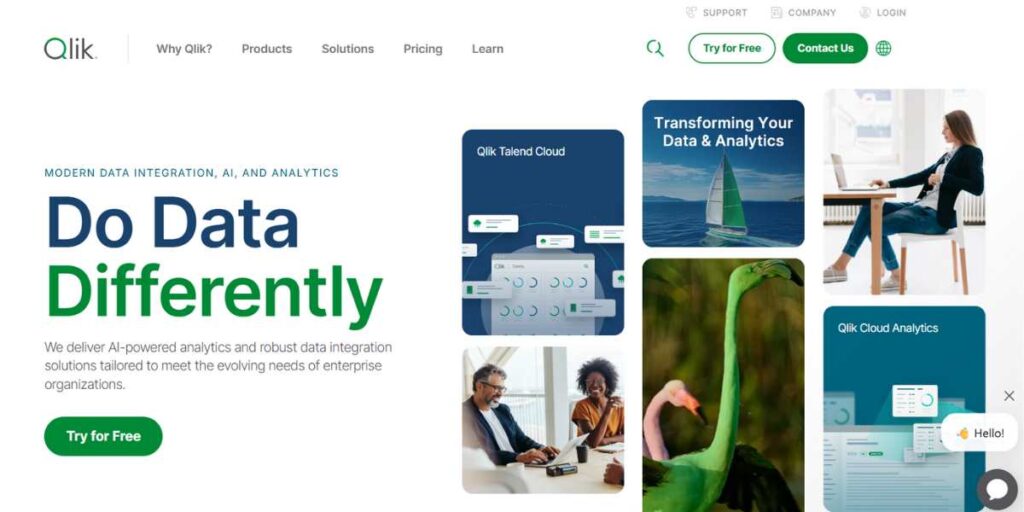
The associative data model of Qlik offers a model of distinct advantages that allow users to analyze and understand the connection between data through interaction and get an immediate response. As one of the leading AI-powered data analytics tools, it is particularly good when it comes to complex data associations, offering robust visualization options to get the most out of an analytics project at scale. The insights engine embedded in the platform can provide the AI-powered pattern recognition and suggestions automatically based on data analysis.
The incorporation of data in real-time is a feature that keeps users working on updated data, and they can make timely decisions. The interactive functions of Qlik ensure that the teams can collaborate and share information and work on the analytical projects. The system has excelled especially in enterprise settings where analytics and data exploration of large volumes is needed.
Key AI Features:
- Versatile explorations data model
- artificial intelligence in generating wisdom and suggestions
- Anomaly identification and pattern auto-recognition
- Analytics conversational interface
- Predictive modelling and modelling tools
Best Use Case: Massive enterprise analytics that not only envisions freedom of data roaming but also has in-depth visualization requirements.
Pricing: $200/mo
Website: https://www.qlik.com/us
6. Databricks
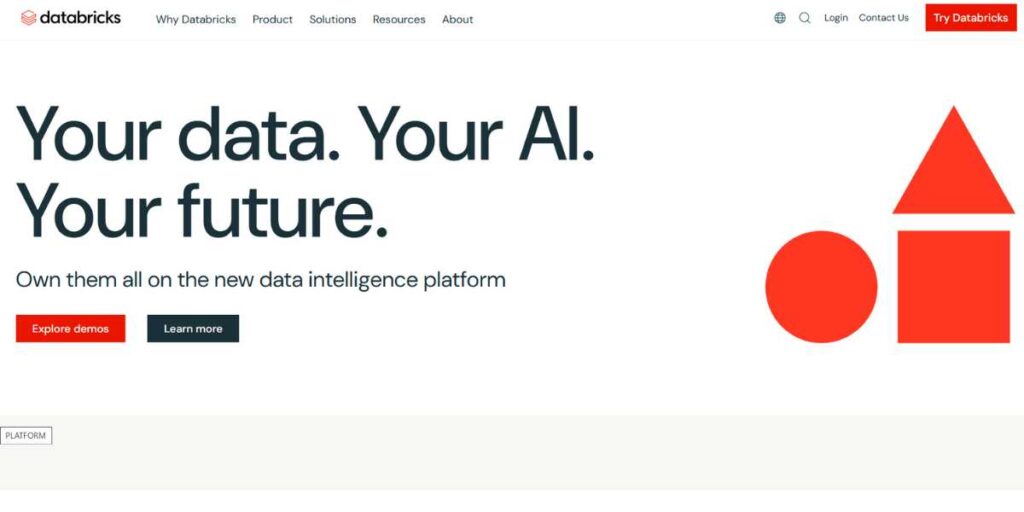
Databricks is also a specialist in big data engineering, machine learning, and advanced analytics, and solutions to data intensive organizations. This is an AI Powered Data Analytics Solution that gives extensive artificial intelligence support in real time processing and modeling of large datasets, therefore it combines well with enormous datasets. The collaborative workspaces of the platform facilitate effective work of data teams on projects of the most complex character.
Excellent support of Apache Spark provides the best possible performance of large scale data processing work. Databricks is great at machine learning model development and deployment and offers the tools used throughout the ML lifecycle.
Key AI Features:
- End-to-end development and deployment of machine learning models
- In real-time data processing and analysis
- Team-based ml workflows and tracking of experiments
- AutoML has auto-model selection
- ETL and data engineering advanced capability
Best Use Case: Large amount of data that needs to be run through advanced machine learning and big data processing.
Pricing: $0.15/DBU
Website: https://www.databricks.com/
7. SAP Analytics Cloud
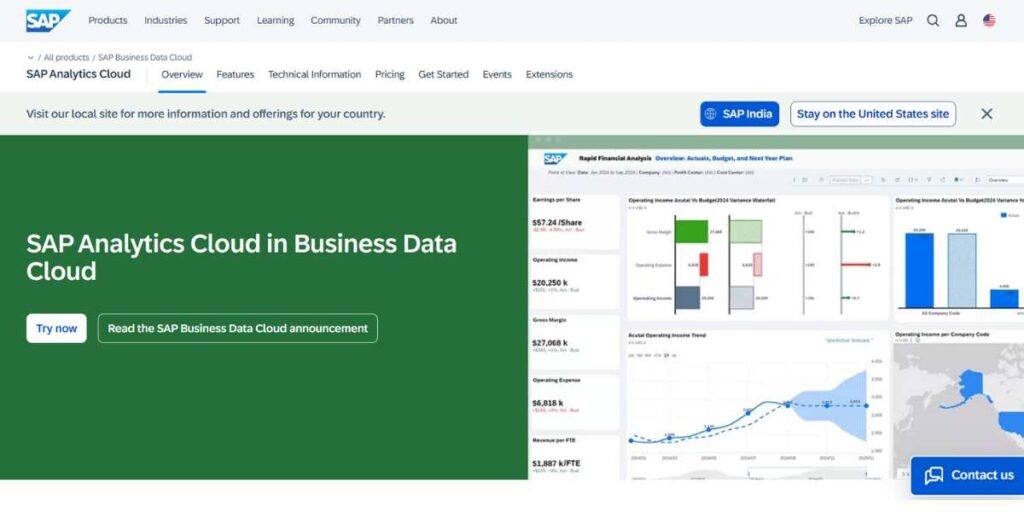
SAP Analytics Cloud brings together the elements of predictive analytics, planning, and business intelligence in a unified platform aimed at providing a thorough business analysis. As one of the most advanced AI-Powered Data Analytics Tools, it offers new AI functionality where complex data becomes more accessible, and this tool can instantly analyze with predictive ability. One of the benefits of the platform is that it fits easily into the current SAP ecosystems, hence this platform is appealing to those organizations that already consume SAP products.
Live data connection provides real-time insights that guarantee users access to up-to-date information to use in their decision-making. The one-stop solution minimizes the number of different tools and platforms used in analysis.
Key AI Features:
- Predictive analysis and machine-learning
- Computerized planning and propelling effort
- Smart knowledge and anomalies identification
- Natural language query processing
- Data preparation tools, based on AI
Best Use Case: Planning, analytics and business intelligence capabilities which are to be merged onto SAP ecosystems.
Pricing: Custom pricing
Website: https://www.sap.com/products/data-cloud/cloud-analytics.html
8. IBM Watson Analytics
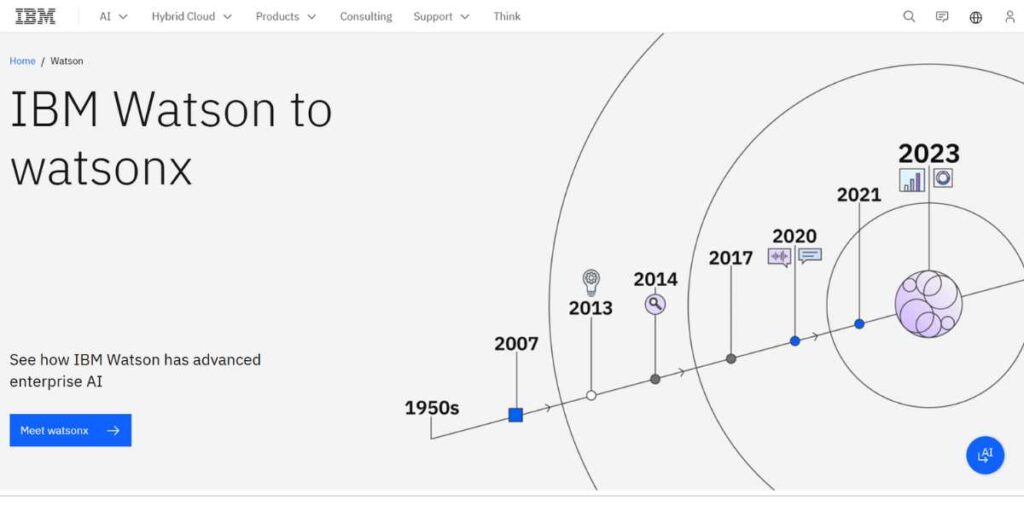
IBM Watson Analytics is a system that uses sophisticated artificial intelligence by delivering an automated data preparation, displaying data, and predictive modeling. That AI-Powered Data Analytics Tool is user friendly, which means that it gives entry to complicated data science to those who do not have in-depth analytical skills by way of simple interfaces. Their natural language processing system on the platform enables a person to ask data conversational queries.
Solid predictive and prescriptive analytics allow organizations to predict trends e.g. and streamline the process of decision-making. The features of security and scalability allow its operation in enterprise environments where the compliance demands are high.
Key AI Features:
- Natural language querying and interaction
- Automated preparation and clean up of data
- Prescriptive and the predictive analytical models
- Wise visualization tips
- Pattern recognition and insights taken with the help of AI
Best Use Case: Discernible experience and lack of the skill to bare with underlying complexities, they also need very powerful predictive analytics.
Pricing: USD 500 per month
Website: https://www.ibm.com/watson
9. Sisense
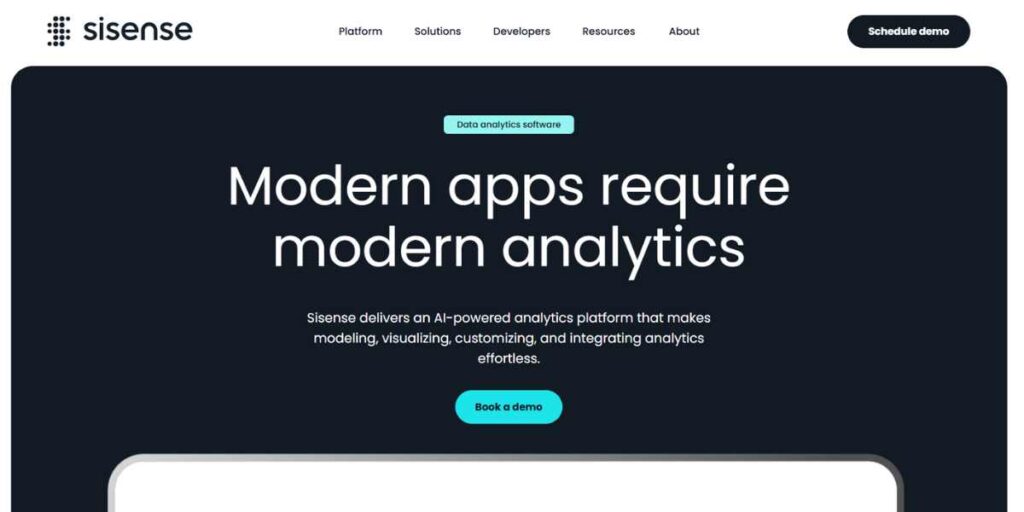
Sisense offers a modern business intelligence system-cum-AI, made to support modern businesses. This artificial intelligent data analytics tool supports end-to-end instant decision making by means of sophisticated API plug-in and developer friendly facilities. The platform is very strong in data visualization and has good customization that can be used by those organizations that have special needs in analysis. Third party application integration is strong and connectivity with any existing business systems is made.
Its user friendliness means that it is available to non technical users yet it offers diverse abilities to the more experienced user. A powerful API support is valuable to the organizations that need bespoke integrations or embedded analytics.
Key AI Features:
- Artificial intelligence-based analysis and source of insight
- Those of data robotic modeling and pertinent preparation
- Intelligent graphical display and dashboards development
- Future prediction and forecasting
- Natural language query functions
Best Use Case: Medium to large business environments that need a customizable business intelligence application that would have high integration capabilities.
Pricing: Custom pricing
Website: https://www.sisense.com/
10. Alteryx
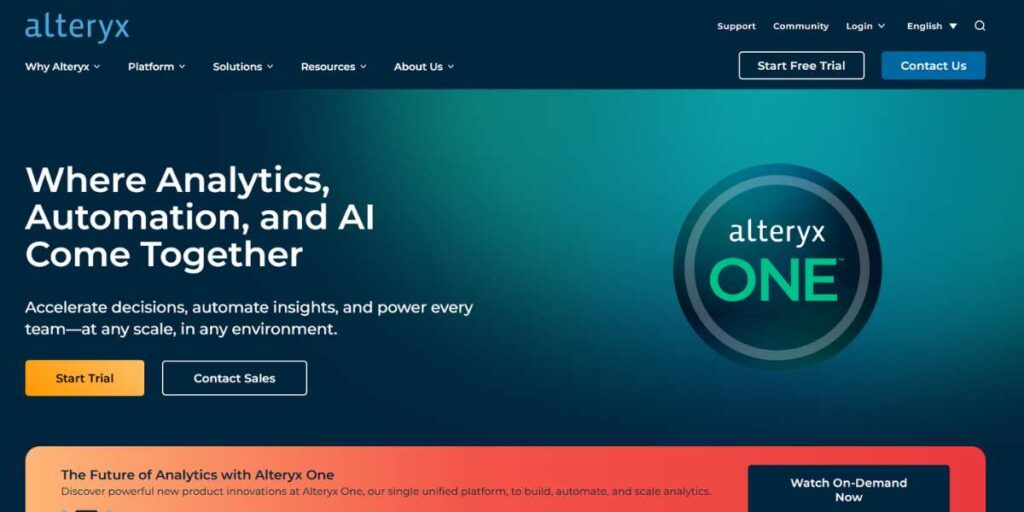
Alteryx specializes in the production of no-coding and low-coding data preparation and data blending and prediction modeling. Advanced analytics are made available to users with minimal programming skills using this AI-Powered Data Analytics Tool which also has wide possibilities of integrating with a wide range of data sources. The site offers highly detailed training material and offers a healthy community support so that users can fully exploit their analytical potential.
Alteryx is a formidable tool when it comes to data preparation and multiple input data can be easily merged using this tool. The ability to use predictive models allows the construction of complex analytical models without the need of coding.
Key AI Features:
- No-code predictive and analytics
- Automatic data cleaning and data combing
- Data profiling and data quality with use of AI
- Development tools of machine learning models
- Smart workflow automation
Best Use Case: Any organization that needs high-performance data preparation and predictive modelling at a high level and would not need huge amounts of code.
Pricing: $250 USD / user / month
Website: https://www.alteryx.com/
How to Choose the Right Tool for Your Business
It is possible to say that the choice of the best analytics platform is to be attentively made under relevance to several organizational considerations and technical needs. The advantages and disadvantages of every AI-Powered Data Analytics Tool depend on its strengths and weaknesses and go in different directions in relation to the business needs.
- Budget: The cost of ownership i.e. license cost, implementation cost, training cost and maintenance cost have to be compared against the expected ROI.
- Scalability: Look at existing data volumes as well as growth projections in the future so that the platform can manage to work within expanding analytical needs.
- Integration: Determine the compatibility with the current systems, databases, and workflows to smooth implementation as much as possible and ensure maximum work efficiency.
- Expertise: link the level of sophistication of the available platform with the level of skills and training capabilities on the technical aspects, to a preferential adoption and usage within groups.
- Features: Differentiate between must-have and nice-to-have features so that you are not overpaying on features that you do not need to use coupled with the fact that the core requirement is met in the system.
Challenges and Limitations
Although promising due to their ability to transform businesses, AI-empowered analytics platforms come with a number of challenges, which need to be overcome to carry out their effective implementation. By knowing such limitations, businesses will be able to prepare correct strategies and expectations.
- Complexity: Sophisticated AI capabilities can entail a lot of technical expertise and training that could create a barrier to other non-technical individuals and groups.
- Cost: AI-enabled enterprise-level platforms can be quite expensive financially and can thus serve as a burden in terms of budget to smaller organizations.
- Privacy: Processing sensitive data with an AI system arouses data security and regulatory issues, and the risk of violation of privacy.
- Accuracy: If not trained on sufficient and unbiased data, the AI-based models can give inaccurate or biased solutions resulting in inefficient business-related decisions.
- Dependency: The over-dependence on automatic insights is liable to reduce the human analysis and critical and analytical evaluation of AI-prospered suggestions and conclusions.
Future Trends in AI & Analytics
The world of analytics is also changing at a very fast rate as AI applications develop and become increasingly complex in terms of business needs. These new trends are bound to determine how organizations do data driven decision making.
- Accessibility: AI-Powered Data Analytics Tools will see an even wider audience as more non-technical individuals will be able to use them, thanks to the interfaces and automation.
- Real-time: The data processing and analysis will happen in real-time and become the norm, allowing us to react to business conditions and market dynamics instantly.
- Integration: A smooth integration between analytics applications and business applications will provide holistic data environments to gain organizational intelligence.
- Personalization: Analytics platforms will learn and adjust to personal users preferences and needs and deliver personalized experiences and relevant knowledge to the user automatically.
Conclusion
The AI-Powered Data Analytics Tools evolution is a paradigm change as far as businesses are concerned in terms of usage of business intelligence and decision-making. Such complex platforms democratize the access to sophisticated analytics and give the never-seen-before ability to generate insights and perform predictive modeling. With a more complex challenge of data being faced by businesses, the appropriate choice of the AI-Powered Data Analytics Tool is one of the critical characteristics that ensure business has competitive advantages and efficient operation.
The platforms mentioned have different strengths and capabilities that fall within the needs and the budget of different organizations. The key to success is an adequate integration of the tool capabilities and business requirements, available resources and strategic orientations. Companies that adopt these smart analytics technologies will be ready, to grow and improve further in the more data-driven market.
Also Read:
Frequently Asked Questions
What is an AI Powered Data Analytics Tool?
An AI-Powered Data Analytics Tool: Data analytics: It is a tool that can be dependent on traditional analytics alongside artificial intelligence to analyze data at an advanced speed, make insights, or predict future trends without requiring a significant portion of manpower to work with.
How do AI analytics tools differ from other traditional business intelligence tools?
The AI tool streamlines data preparation, offers predictive insights, and automatizes data analysis by generating insights, whereas the traditional BI solution is centered around historical reporting, and must be operated manually.
What is the best AI-Powered Data Analytics Tool to be used by small businesses?
Polymer and Microsoft Power BI are more economical solutions that are user friendly making them ideal choices among small businesses that lack depths of tech knowledge along with budgets.
Do I have to be able to code to use AI analytics platforms?
Most Data Analytics Tools currently available that use AI Technology are no-codes or low-codes, which can be used by a person with no formal technical introduction but does have a basic understanding of how to use their machine.
What should I consider when choosing an AI analytics platform?
When choosing an AI-Powered Data Analytics Tool, consider your budget, your scalability requirements, the integration requirements, team expertise and key features you need an AI-Powered Data Analytics Tool to cover and long-term business goals.